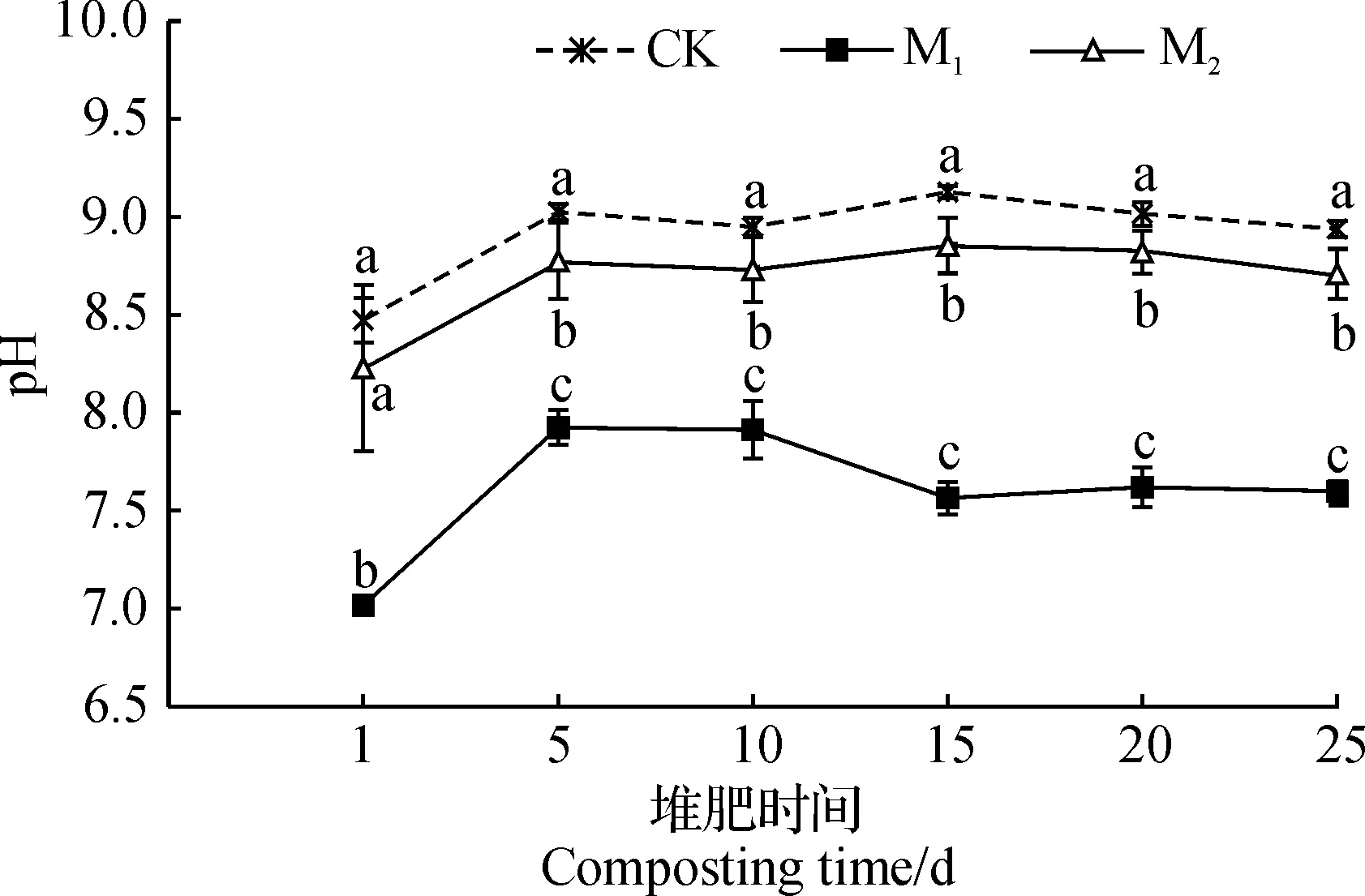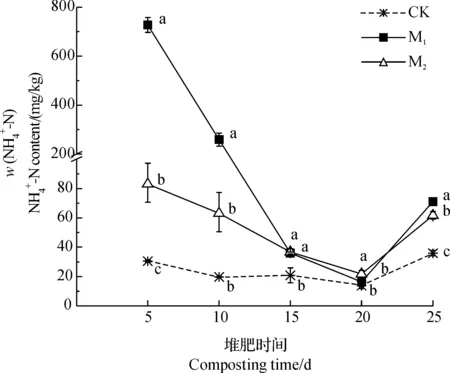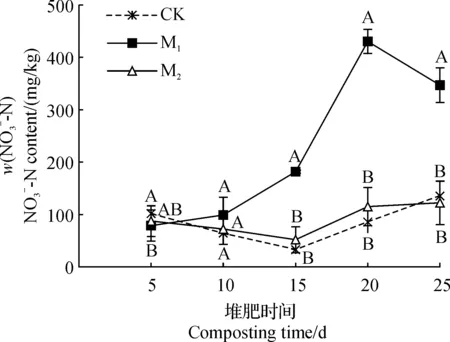浓缩味精废液作为高温堆肥调酸保氮剂的适宜添加时间研究
2016-08-15孔海民刘丽李田宇汪继兵方萍
孔海民, 刘丽, 李田宇, 汪继兵, 方萍,*
(1.浙江大学环境与资源学院,污染环境修复与生态健康教育部重点实验室,杭州 310058;2.浙江省农业技术推广中心,杭州 310020;3.贵州大学农学院农业资源与环境系,贵阳 550025;4.浙江大学环境与资源学院,浙江省亚热带土壤与植物营养重点研究实验室,杭州 310058)

浓缩味精废液作为高温堆肥调酸保氮剂的适宜添加时间研究
孔海民1,2, 刘丽1,3, 李田宇1, 汪继兵4, 方萍1,4*
(1.浙江大学环境与资源学院,污染环境修复与生态健康教育部重点实验室,杭州 310058;2.浙江省农业技术推广中心,杭州 310020;3.贵州大学农学院农业资源与环境系,贵阳 550025;4.浙江大学环境与资源学院,浙江省亚热带土壤与植物营养重点研究实验室,杭州 310058)

浓缩味精废液; 猪粪; 高温堆肥; pH; 氮素损失
Summary The pH rise of the compost mixture is one of the main causes for nitrogen volatilization loss in the composting process. As a consequence of organic degradation, accumulated ammonium nitrogen will trigger pH rise spontaneously. It is generally believed that ammonia nitrogen (NH3) will volatilize once the pH of compost mixture exceeds 8.0. And the higher the pH is, the more the NH3volatilization will be. In this way, the pH rise of mixture will result in substandard compost products, not only because its pH is out of the upper limit (pH=8.5) of the NY 525—2012 standard, but also significant decline of nutrition content due to NH3volatilization. Hence, adjusting the pH of materials to control nitrogen loss becomes one of the hot issues in the organic fertilizer industry. A lot of chemical agents have been applied to adjust the pH in composting. However, most of them are difficult to implement efficiency and decrease production cost, let alone the dilution effects and imbalance of nutrition. The concentrated monosodium glutamate wastewater (CMGW) is an evaporative and concentrated liquid waste from discharged organic water in production of monosodium glutamate, characterized by rich nutrients and free heavy metal pollution. Previous studies have indicated that CMGW is a promising conditioning agent to adjust acidity and reduce NH3volatilization for composting, and the suggested optimum dosage is 2% of the mixture in mass.
The appropriate adding time of CMGW for adjusting pH and decreasing nitrogen loss due to NH3volatilization in composting was further discussed in present study by a compost simulation experiment. The simulation experiment took place in a composting device (patent number: ZL 201010589910X) with the mixture of fresh pig manure and mushroom residues at a ratio of 3∶1 in mass, as well as 1% fermentation bacterial agent of the mixture. Three treatments were conducted as follows: 1) M1, application of 2% CMGW before composting; 2) M2, application of 2% CMGW at the 5th day of composting; 3) CK, control group without CMGW.


高温堆肥是实现畜禽养殖废弃物无害化、资源化最为有效的途径[1],但在堆肥升温和高温阶段,由于微生物大量繁殖,有机物加速分解,大量铵态氮在堆体中积聚,使物料pH值升高,引起氮素中的NH3挥发损失[2],不仅会加剧堆肥场的恶臭,降低肥料中的养分含量,也常常导致堆肥产品pH超标[3],达不到农业部有机肥行业标准NY 525—2012规定的酸碱度(pH 5.5~8.5)的要求。如何调节物料pH值来控制氮素损失已成为有机肥行业关注的热点。目前,用于堆肥物料调酸保氮的物质主要有磷酸、硫酸铝[4]、氢氧化镁[5]、硫酸亚铁、过磷酸钙[6-7]、草炭和沸石[8]等,但是这些调理剂必须达到足够的添加量才能发挥作用。据王秀娟等[9]报道,在鸡粪堆肥中添加3%硫酸亚铁、10%过磷酸钙、9%草炭才能达到良好的保氮效果。然而,大量添加硫酸亚铁、氢氧化镁和沸石等化学调理剂不仅增加了有机肥的生产成本,还因稀释效应使产品的养分含量降低;同时,大量添加磷酸或过磷酸钙作为调酸保氮剂会造成堆肥产品含磷量过高,进而导致有机肥氮磷钾3要素配比失衡,在实践中难以被有机肥生产企业广泛接受。为此,寻找价廉质优、资源丰富的堆肥物料的调酸保氮材料是提高有机肥品质、拓展有机肥市场的有效保障。
浓缩味精废液是在味精生产中产生的离交尾液的蒸发浓缩液,具有营养物质(主要为菌体蛋白质、氨基酸、还原糖、N、P、K及微量元素等)丰富、pH低、无重金属超标等特性,可望用作堆肥物料的调理剂解决堆肥过程中产品pH超标及其造成的氮素挥发损失等问题。本课题组前期已通过不同浓缩味精废液添加量的堆肥物料高温培养试验对此进行了验证,结果[10]表明,添加浓缩味精废液可以降低堆肥物料的pH和NH3挥发量,其添加量为堆肥物料质量1%和3%处理的NH3日挥发量比对照分别降低了22.8%~39.7%和65.3%~78.9%;相继3次每隔3 d添加1%和2%浓缩味精废液处理的10 d累积NH3挥发总量分别比对照降低了15%和71%,培养25 d后堆肥物料pH分别从对照的9.1降至8.5和7.7。本文拟进一步通过堆肥模拟试验,研究堆肥过程中浓缩味精废液添加时间对其调酸保氮效果的影响。
1 材料与方法
1.1供试材料
新鲜猪粪取自浙江大学华家池校区牧场;经风干粉碎后的菇渣取自浙江省金华市丰源农业科技有限公司;浓缩味精废液由安徽环宇肥料有限公司提供;发酵菌剂是由本实验室自行研发制备的混合菌剂;用于发芽指数测定的黄瓜种子购自浙江省勿忘农种业有限公司。供试原料的基本理化性质见表1。

表1 供试原料的基本理化性质
CMGW: Concentrated monosodium glutamate wastewater.
1.2试验方法
试验采用的模拟堆肥装置由本课题组设计发明(专利号:ZL 201010589910X)。将新鲜猪粪和菇渣按质量比3∶1混合,添加混合物质量1%的发酵菌剂进行堆置。分别在堆置前和堆置5 d时添加堆肥物料质量2%的浓缩味精废液,并设不添加的为对照,共3个处理,分别记作M1、M2和CK。将物料与浓缩味精废液充分混匀,调节堆肥物料含水率至62%左右,装入模拟堆肥装置中,7.5 kg/桶,各处理重复3桶。试验第1周每隔2 h用气泵对物料强制通气30 min,通气量为25 L/min,第2周停止通气。每5 d翻堆一次并取样,样品分为鲜样和烘干样,分别进行理化性质测定。
1.3测定项目及方法

堆肥物料的腐熟程度由物料鲜样的种子发芽指数评价[12]。种子发芽指数测定过程:在直径9 cm的培养皿内先垫1张滤纸,均匀放入20颗黄瓜种子后加入发酵物料的浸提液(在10 g物料新鲜样品中加入100 mL蒸馏水,搅拌浸泡30 min)5.0 mL,于25 ℃黑暗培养箱中培养48 h后测定发芽率和根长,每个样品重复3次,同时用蒸馏水作为对照。
种子发芽指数/%=(处理发芽率×处理根长)/(空白发芽率×空白根长)×100。
1.4数据分析
试验数据采用Excel 2007整理及作图,利用DPS V14.50软件[13]进行方差分析和最小显著差异法多重比较。
2 结果与分析
2.1堆体中心温度的变化动态
由图1可见,在整个堆肥过程中堆肥物料温度高于环境温度,堆肥伊始堆体中心温度急剧上升,至第3天升至50 ℃,至第4天高达55 ℃以上,随后除了因每隔5 d翻堆取样时温度有所降低外,直至第15天基本保持在50 ℃以上,此后逐步回落至45 ℃以至35 ℃。3个处理间的差异并不明显。说明添加浓缩味精废液对堆肥物料升温无明显影响。

CK:未添加浓缩味精废液;M1:堆肥开始前添加物料质量2%的浓缩味精废液;M2:堆肥启动后5 d添加物料质量2%的浓缩味精废液;AT:环境温度。CK: Without concentrated monosodium glutamate wastewater (CMGW); M1: Application of 2% CMGW before composting; M2: Application of 2% CMGW at the 5th day of composting; AT: Environmental temperature.图1 不同处理堆体中心温度变化动态Fig.1 Change dynamic of central temperature of compost matrix under different treatments
2.2堆肥物料pH变化动态
图2显示:堆肥起始第1天处理M1的物料pH显著低于此时尚未添加浓缩味精废液的处理M2和对照CK;此后的整个堆肥过程中CK的物料pH不仅显著高于M1和M2,而且都超过8.5,最终高达8.9,超出NY 525—2012规定的有机肥酸碱度标准的上限8.5;此外,M1处理的物料pH始终低于M2。说明在堆肥升温前添加浓缩味精废液对物料的调酸效果优于升温后添加。
2.3堆肥物料含水率变化动态
图3表明:堆肥物料的含水率在堆肥起始的前5 d急剧下降,至第10天略有回升,随后又缓慢下降;在整个堆肥过程中,M1的含水率始终低于CK和M2,并与CK的差异有统计学意义(P<0.05);M2的变化曲线也一直位于CK之下,第10天、15天和25天均与CK差异达统计学上的显著水平(P<0.05)。说明添加浓缩味精废液有利于堆肥物料的水分散失,且堆肥开始前添加的效果比物料升温后添加更为明显。

各处理符号表示的含义详见图1注。图上不同小写字母表示在同一堆肥时间下不同处理间在P<0.05水平差异有统计学意义。Please see footnote of Fig.1 for details of each treatment. Different lowercase letters mean statistically significant differences among different treatments at the same composting time at the 0.05 probability level.图2 不同处理堆肥物料pH值变化动态Fig.2 Change dynamic of the pH value of compost mixture under different treatments

各处理符号表示的含义详见图1注。图上不同小写字母表示在同一堆肥时间下不同处理间在P<0.05水平差异有统计学意义。Please see footnote of Fig.1 for details of each treatment. Different lowercase letters mean statistically significant differences among different treatments at the same composting time at the 0.05 probability level.图3 不同处理堆肥物料含水率变化动态Fig.3 Change dynamic of moisture content of compost mixture under different treatments


各处理符号表示的含义详见图1注。图上不同小写字母表示在同一堆肥时间下不同处理间在P<0.05水平差异有统计学意义。Please see footnote of Fig.1 for details of each treatment. Different lowercase letters mean statistically significant differences among different treatments at the same composting time at the 0.05 probability level.图4 不同处理堆肥物料-N含量变化动态Fig.4 Change dynamic of -N content of compost mixture under different treatments


各处理符号表示的含义详见图1注。图上不同大写字母表示在同一堆肥时间下不同处理间在P<0.01水平差异有统计学意义。Please see footnote of Fig.1 for details of each treatment. Different capital letters mean statistically significant differences among different treatments at the same composting time at the 0.01 probability level.图5 不同处理堆肥物料-N含量变化动态Fig.5 Change dynamic of -N content of compost mixture under different treatments
2.5堆肥前后物料理化性质变化
堆肥开始和结束时物料pH、电导率、全氮含量和种子发芽指数如表2所示。堆肥开始时,添加浓缩味精废液处理M1的pH显著低于未添加的2个处理CK和M2;M1的电导率显著高于M2和CK;M1的全氮含量略高于M2和CK;3个处理的种子发芽指数均低于60%,表明都尚未腐熟。经25 d堆置后,即堆肥结束时3个处理物料的4项指标都有不同程度的上升,其中pH以CK高达8.9而明显超标,M2为8.7,显著低于CK但仍超标,M1最低(7.6),已经达标;电导率为M1>M2>CK,差异有统计学意义(P<0.01);M1的全氮含量最高,显著高于M2,极显著高于CK;3个处理的种子发芽指数均超过110%,说明均已腐熟。
表2堆肥前后物料pH值、电导率(EC)、全氮(TN)及种子发芽指数(GI)的变化
Table 2Change of compost mixture pH, electrical conductivity (EC), total nitrogen (TN) content and seed germination index (GI) under different treatments before and after composting

处理Treatments 0d 25d pHEC mS cm w TN g kg GI %pHEC mS cm w TN g kg GI %CK8 5aA1 81bB18 32ab55 0a8 9A1 93C27 96bB121 6aM17 0bB3 08aA19 11a48 0a7 6C3 67A29 02aA114 2aM28 2aA1 78bB18 03b52 0a8 7B2 32B28 12bAB114 5a
同列数据后的不同小写或大写字母分别表示在P<0.05或P<0.01水平差异有统计学意义。
The values followed by different lowercase or capital letters in the same column mean statistically significant differences at the 0.05 or 0.01 probability level, respectively.
3 讨论

[1]程绍明,马杨晖,姜雄晖.我国畜禽粪便处理利用现状及展望.农机化研究,2009,31(2):222-224.
CHENG S M, MA Y H, JIANG X H. Comprehensive utilization technologies of livestock manure.JournalofAgriculturalMechanizationResearch, 2009,31(2):222-224. (in Chinese with English abstract)
[2]李顺义,张红娟,郭夏丽,等.畜禽粪便堆肥过程中氨挥发及调控措施.农机化研究,2010,32(1):13-17.
LI S Y, ZHANG H J, GUO X L,etal. Ammonia volatilization and the regulation measures in the livestock manure compost.JournalofAgriculturalMechanizationResearch, 2010,32(1):13-17. (in Chinese with English abstract)
[3]李帆,朱宏斌,郭熙盛,等.畜禽粪便高温堆肥过程中氨挥发的机制及控制.安徽农业科学,2008,36(25):10996-10997.
LI F, ZHU H B, GUO X S,etal. Mechanism of ammonia volatilization and technique for nitrogen conservation in composting of livestock manure.JournalofAnhuiAgriculturalSciences, 2008,36(25):10996-10997. (in Chinese with English abstract)
[4]DELAUNE P B, MOORE P J, DANIEL T C,etal. Effect of chemical and microbial amendments on ammonia volatilization from composting poultry litter.JournalofEnvironmentalQuality, 2004,33(2):728-734.
[5]任丽梅,贺琪,李国学,等.氢氧化镁和磷酸混合添加剂在模拟堆肥中的保氮效果研究及其经济效益分析.农业工程学报,2008,24(4):225-228.
REN L M, HE Q, LI G X,etal. Effect of Mg(OH)2and H3PO4amendments on nitrogen conservation during simulated aerobic composting and its benefit analyses.TransactionsoftheChineseSocietyofAgriculturalEngineering, 2008,24(4):225-228. (in Chinese with English abstract)
[6]胡明勇,刘强,陈雄鹰,等.2种钙化合物在猪粪-稻草堆肥中除臭及保氮效果研究.湖南农业科学,2009(7):51-54.
HU M Y, LIU Q, CHEN X Y,etal. Deodorization and nitrogen preservation effects of two kinds of calcium compound in compositing of pig-manure combined with straw.HunanAgriculturalSciences, 2009(7):51-54. (in Chinese)
[7]史春梅,王继红,李国学,等.不同化学添加剂对猪粪堆肥中氮素损失的控制.农业环境科学学报,2011,30(5):1001-1006.
SHI C M, WANG J H, LI G X,etal. Control of different chemical additives on nitrogen loss during composting of pig manure.JournalofAgro-EnvironmentScience, 2011,30(5):1001-1006. (in Chinese with English abstract)
[8]熊建军,刘淑英,邹国元,等.高温堆肥过程中除臭保氮技术研究进展.中国农学通报,2008,24(1):444-448.
XIONG J J, LIU S Y, ZOU G Y,etal. Research progress on deodorizing and reducing nitrogen loss from high temperature compost system.ChineseAgriculturalScienceBulletin, 2008,24(1):444-448. (in Chinese with English abstract)
[9]王秀娟,刘慧颖,孙文涛,等.有机肥发酵氮素损失调控技术研究.杂粮作物,2004,24(4):236-237.
WANG X J, LIU H Y, SUN W T,etal. Control techniques of nitrogen loss in organic fertilizer fermentation.RainFedCrops, 2004,24(4):236-237. (in Chinese)
[10]LIU L, KONG H M, LU B B,etal. The use of concentrated monosodium glutamate wastewater as a conditioning agent for adjusting acidity and minimizing ammonia volatilization in livestock manure composting.JournalofEnvironmentalManagement, 2015,161:131-136.
[11]鲁如坤.土壤农业化学分析方法.北京:中国农业科学技术出版社,2000:107-160.
LU R K.AnalyticalMethodsofSoilAgrochemistry. Beijing: China Agricultural Science and Technology Press, 2000:107-160. (in Chinese)
[12]黄国锋,吴启堂,孟庆强,等.猪粪堆肥化处理的物质变化及腐熟度评价.华南农业大学学报,2002,23(3):1-4.
HUANG G F, WU Q T, MENG Q Q,etal. Substance changes and maturity evaluation during pig manure composting.JournalofSouthChinaAgriculturalUniversity, 2002,23(3):1-4. (in Chinese with English abstract)
[13]TANG Q Y, ZHANG C X. Data Processing System (DPS) software with experimental design, statistical analysis and data mining developed for use in entomological research.InsectScience, 2013,20(2):254-260.
[14]单德鑫,李淑芹,许景钢.固体有机废物堆肥过程中氮的转化.东北农业大学学报,2007,38(2):265-269.
SHAN D X, LI S Q, XU J G. Nitrogen transformations in solid organic waste composting.JournalofNortheastAgriculturalUniversity, 2007,38(2):265-269. (in Chinese with English abstract)
[15]REECE F N, BATES B J, LOTT B D. Ammonia control in broiler houses.PoultryScience, 1979,58:754-755.
[16]MOORE JR P A, HUFF W E, DANIEL T C,etal. Effect of aluminum sulfate on ammonia fluxes from poultry litter in commercial broiler houses//Proceedings of Fifth International Symposium on Livestock Environment.TransactionsoftheASAE, 1997,2:883-891.
[17]郑瑞生,肖本木,李延.堆肥化过程中氮素转化和NH3挥发研究.泉州师范学院学报,2007,25(2):122-125.
ZHENG R S, XIAO B M, LI Y. A study on nitrogen transformation and NH3emission during composting.JournalofQuanzhouNormalCollege, 2007,25(2):122-125. (in Chinese with English abstract)
[18]李静,陈志良.接种硝化菌剂降低猪粪堆肥氮素损失的研究.安徽农业科学,2011,39(15):8976-8978.
LI J, CHEN Z L. Study on reducing nitrogen loss using nitrifying bacteria inoculants in pig dung compost.JournalofAnhuiAgriculturalSciences, 2011,39(15):8976-8978. (in Chinese with English abstract)
[19]鲍艳宇,周启星,颜丽,等.畜禽粪便堆肥过程中各种氮化合物的动态变化及腐熟度评价指标.应用生态学报,2008,19(2):374-380.
BAO Y Y, ZHOU Q X, YAN L,etal. Dynamic changes of nitrogen forms in livestock manure during composting and relevant evaluation indices of compost maturity.ChineseJournalofAppliedEcology, 2008,19(2):374-380. (in Chinese with English abstract)
[20]罗泉达,黄惠珠,郑长焰,等.猪粪堆肥的腐熟度指标.福建农林大学学报(自然科学版),2009,38(1):84-87.
LUO Q D, HUANG H Z, ZHENG C Y,etal. The indices of swine manure compost maturity.JournalofFujianAgriculturalandForestryUniversity(NaturalScienceEdition), 2009,38(1):84-87. (in Chinese with English abstract)
Appropriate adding time of concentrated monosodium glutamate wastewater as acidity adjusting and nitrogen loss control agent in high temperature composting.JournalofZhejiangUniversity(Agric. &LifeSci.), 2016,42(4):495-501
KONG Haiming1,2, LIU Li1,3, LI Tianyu1, WANG Jibing4, FANG Ping1,4*
(1.KeyLaboratoryofEnvironmentRemediationandEcologicalHealthoftheMinistryofEducation,CollegeofEnvironmentalandResourceSciences,ZhejiangUniversity,Hangzhou310058,China; 2.AgriculturalTechnologyPopularizationCenterofZhejiangProvince,Hangzhou310020,China; 3.DepartmentofAgriculturalResourceandEnvironment,CollegeofAgriculture,GuizhouUniversity,Guiyang550025,China; 4.ZhejiangProvincialKeyLaboratoryofSubtropicalSoilandPlantNutrition,CollegeofEnvironmentalandResourceSciences,ZhejiangUniversity,Hangzhou310058,China)
concentrated monosodium glutamate wastewater; pig manure; high temperature compost; pH; nitrogen loss
国家自然科学基金(31272242).
Corresponding author):方萍(http://orcid.org/0000-0001-7784-7873),Tel:+86-571-88982480,E-mail:pfang@zju.edu.cn
联系方式:孔海民(http://orcid.org/0000-0001-7014-426X),E-mail:konghaimin2004@163.com
2015-08-13;接受日期(Accepted):2015-11-27;网络出版日期(Published online):2016-04-12
S-3; X 703
A
URL:http://www.cnki.net/kcms/detail/33.1247.S.20160412.1447.002.html
